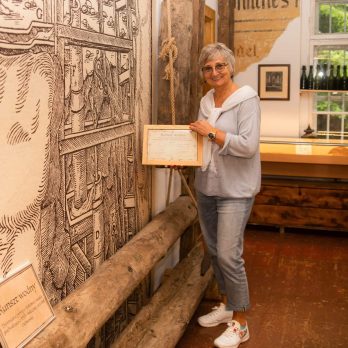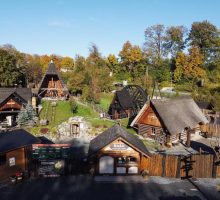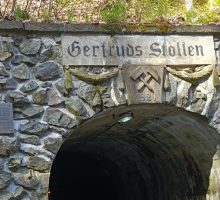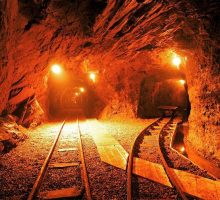One of the key objectives of the MINEX Europe Forum is to share best practices in mineral resources management, mining and post-mining reconciliation and redevelopment of mining areas. The Forum delegates will have an opportunity to visit one of the most prominent cases of the repurposing of the old mine turned into a grand tourist attraction in Poland which has in 2022 won the prestigious European Heritage Award.

Visit to Złoty Stok Medieval Gold Mine
About Złoty Stok
Złoty Stok is situated only 18 km from Kłodzko (17 min drive) and 86 km from Wrocław (1.5 h drive)

What is included
Tour length 4-5 hours (excluding transfers)
- Coach transfer from and back to ibis Styles Wroclaw Centrum
- Welcome on arrival, Underground rafting by boat Gertruda Adit, Walk of underground tunnels Ochrowa Addit, Mining Museum, Medieval Mining Village and Technology Centre, Group lunch at “Stara Kuźnia” (The Old Smith Workshop) Inn.
- English speaking guide
- Lunch at “Stara Kuźnia” Inn
Clothing
The temperature in the Gold Mine and the Ochrowa Adit underground ranges from 7-10ºC. Please wear comfortable shoes and bring warm clothes – according to the conditions on the route.
About the Tour
The Gold Mine in Złoty Stok is one of the most interesting tourist attractions in Lower Silesia. It is a specially prepared tourist route with a museum exhibition, including two adits.
In the first of them – Gertrude (500 m) – visitors can admire a unique collection of geological maps, old mining geodetic instruments, crucibles and a gold smelting furnace, rich a collection of rocks, ores and minerals from around the world.
The second adit – Black (700 m) – is located in the upper part of Złoty Jar. Here, the greatest impression on tourists is made by the only one in Poland, a magnificent underground waterfall with a height of 8 meters treasures. The tour ends with a ride on the Underground Orange Tram on the 300 m route. During the tour in both adits, visitors can learn about mining techniques used over the centuries, admire the only underground waterfall in Poland, take a ride on an underground tram, mint a commemorative coin with their own hands, take part in gold panning, watch a gold bar casting show, make handmade gold paper or watch exhibition of minerals.
There is also the Ochrowa Adit, considered the most beautiful adit in the Golden Mountains, and the Medieval Technology Park, which is a replica of a medieval mining settlement equipped with devices constructed on a 1: 1 scale based on engravings and descriptions by Georgius Agricola. Additional attractions on the premises of the facility are: the Minerals Museum and the Memorial Hall, sailing in a boat along the underground corridor, climbing wall, a ride on a replica of a Leonardo da Vinci tank, and a medieval playground.
At the end of the tour, delegates will be invited for lunch the “Stara Kuźnia” (The Old Smith Workshop) Inn hidden between the mysterious excavations of the former shafts and tunnels of the Gold Mine in Złoty Stok.
The visitors will be welcomed by Maciej Dziczkowski – the daughter of Elżbieta Szumska and current CEO of the Złoty Stok Mine.
A bit of history
Złoty Stok is the oldest mining and metallurgical centre in Poland. Arsenic and gold deposits were mined in these areas as early as the 13th century. Mining activity flourished in the 16th century. In the golden age of mining, there could be as many as 150 small and larger mines in the area In 1962, the mine in Złoty Stok ceased its activity, and later it was completely flooded. It is estimated that during 700 years of exploitation, 16 tonnes of pure gold were obtained from local deposits.
On May 28, 1996, the Underground Tourist Route “Gold Mine” was launched. Extremely interesting tunnels were made available: “Gertuda Adit”, and “Black Upper Adit” with the only underground waterfall in Poland (8 m high) and the newest section, open to the public since 2008, the Lower Black Adit.

Elżbieta Szumska
An inspiring example of how to develop a sustainable business model around cultural heritage
When the underground Kopalnia Museum opened to the public in 1996, Elżbieta Szumska started working there as a tour guide and developed a deep appreciation for the mine’s heritage and history. In 2001 she became Kopalnia’s main shareholder and went with her two daughters on a long and inspiring journey of restoration of the whole area. Elżbieta Szumska has contributed, personally and financially, to the restoration of many local monuments, published several books on the history of the area and established fruitful relations with philanthropic organisations in both Poland and Germany.
Through her research, Elżbieta Szumska found 3 lost adits – entrances to the mines – which she restored and opened to the public. In 2014 she founded Izba Pamienci, a museum that displays thousands of items of historical value, which is accredited by the Polish Ministry of Culture and Heritage. Some of the artefacts were found by Elżbieta Szumska herself, with others donated by Złoty Stok’s citizens and by people who had moved abroad in the post-war period. Of the most valuable exhibits are the original gold coins which date to the 16th century. She was also successful in finding the last living descendant of the last German owners of the gold mine, 92-year-old Barbara Guttler, which led to the discovery of previously unknown stories, souvenirs and photographs, which are each invaluable to the history of the Kłodzko city.











